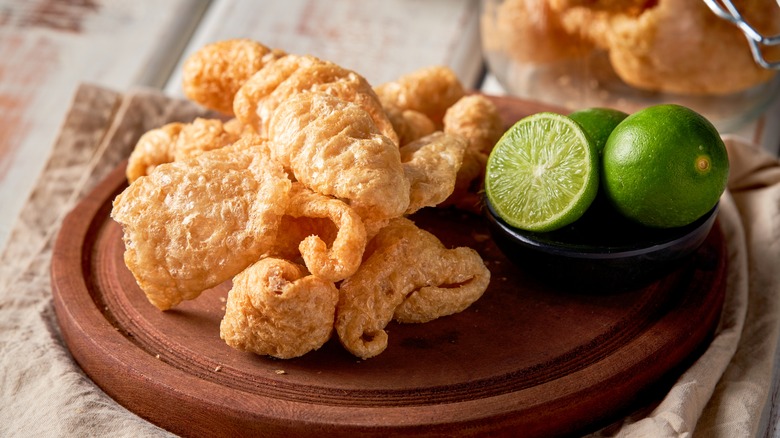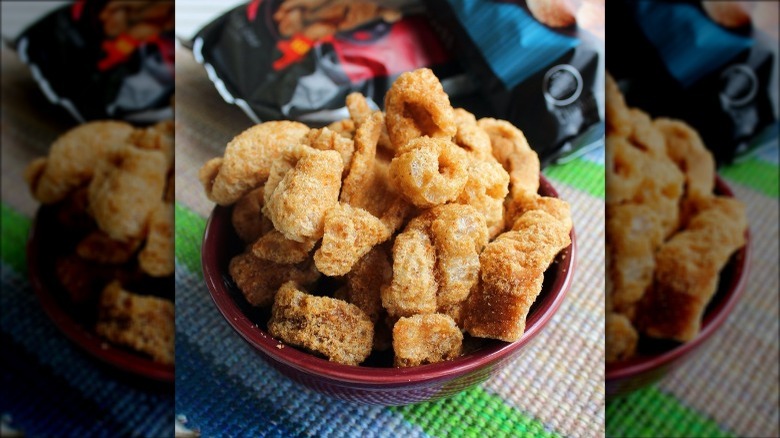The Differences Between Pork Rinds, Cracklins, And Fatback
Despite some similarities, pork rinds, cracklins, and fatback are not the same. In fact, these delicious yet misunderstood pork products vary quite a bit when it comes to origins, textures, and flavors. Although bacon tends to get the most love when it comes to pork preparations, it lacks the flavor intensity of fatback. It also can't rival the light, pleasing crunch of pork rinds and cracklins.
Whether enjoyed as a snack or used to enhance other recipes, these pork products have played an important role in U.S. culinary culture, particularly in the southern portion of the country. These recipes were also borne out of necessity, as many people lacked access to expensive cuts of meat and had to make do with "less desirable" parts of the animal. However, all three preparations remain a cherished aspect of culinary tradition to this day, in both the U.S. and throughout the world. If you've ever wondered how pork rinds, cracklins, and fatback differ, here are some key points to consider.
Pork rinds
Pork rinds are best known for their crunchy, airy texture. While they're an important aspect of southern culinary tradition, many cultures enjoy a version of pork rinds(which surprisingly make for a great hot dog topping). In Newfoundland, Canada, scrunchions are a traditional dish consisting of fried, salted pork skins. Chicharrones are the Spanish/Latin iteration of the snack, as they undergo an almost identical cooking process. However, chicharrones typically include some portion of fat, whereas pork rinds consist mostly of pig skin.
To create pork rinds, pig skins are simmered in hot water to remove as much of the fat as possible. The skins are then cut into smaller pieces and chilled to allow the remaining fat to turn solid. Next, any lingering fat is trimmed away, and the skins are cooked to reduce their moisture content. After dehydrating in the oven for many hours, the final step entails deep frying in oil, which creates the pleasing texture associated with this beloved food. The primary difference between pork rinds and similar preparations is the lack of fat, which influences not only texture but also taste. Some say they have a mild flavor, similar to chicken skin, which could be due to the lack of pork fat in the recipe.
Cracklins
Cracklins are said to have originated from the Cajun boucherie tradition, a community-wide pig slaughter where an effort was made to use every part of the animal (boucherie translates to "butcher's shop" in English). The Cajun people, formerly known as French Acadians and hailing from Nova Scotia, made their home in Louisiana during the late 1700s. The diverse mix of people in this region — which included Native American tribes, Creole peoples (including enslaved West Africans and their descendants), and European immigrants — helped shape Cajun culture, which is now synonymous with Louisiana.
Cracklins remain a treasured snack in Louisiana and other parts of the southern U.S. and bear some similarities to pork rinds. The key difference is in the fat content, as cracklins consist of both pig skin and portions of fat. There are also two different versions: Hard cracklins are smoked and cooked in their own fat, while tender cracklins are fried after smoking and cooking. The fat imbues cracklins with a robust flavor similar to bacon, while the texture is denser and chewier than pork rinds.
Fatback
While pork rinds and cracklins are all about the crispy pig skin, fatback is all about the fatty portion of the animal, hence the name. Derived from a dense section of fat around the spine, fatback is often cut into strips and fried. However, it can also be salted and cured. Like pork rinds, versions of fatback can be found throughout the world, including in France and Italy. However, the preparation is a culinary staple when it comes to Southern cooking traditions.
Fatback offers the most intense flavor when compared to other pork-derived treats, with a texture similar to bacon, albeit with a much higher fat content than your average slab. In addition to being enjoyed as a snack, fatback can also be added to foods to boost flavor. For instance, it's often added to collard greens and other vegetables to imbue them with a rich, meaty flavor. It's also a standard accompaniment to beans, soups, and stews.
Pork rinds, cracklins, and fatback are great examples of the culinary ingenuity exhibited by people with limited resources. They also show the benefits of using every portion of an animal in cooking, which reduces waste and results in unbelievable flavors that might not otherwise be discovered. Perhaps that's why these snacks still retain an important place in culinary cultures all over the world.



